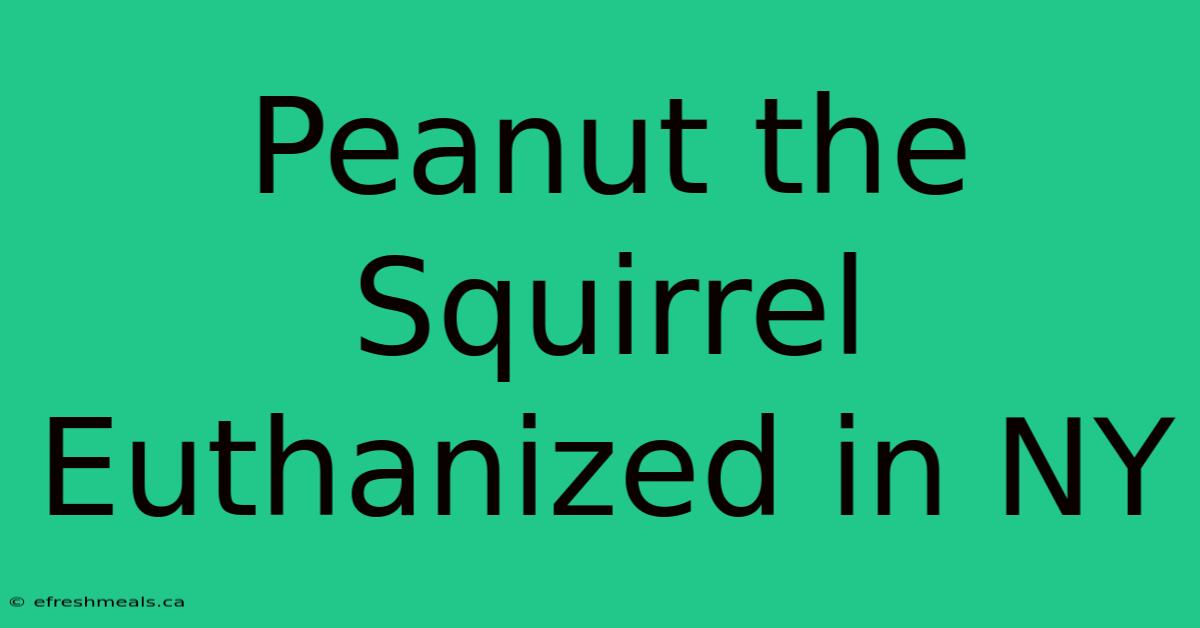Peanut The Squirrel Euthanized In NY

Discover more detailed and exciting information on our website. Click the link below to start your adventure: Visit Best Website nimila.me. Don't miss out!
Table of Contents
Peanut the Squirrel Euthanized in NY: A Tale of Wildlife Rescue and Difficult Choices
Editor's Note: The recent euthanasia of Peanut the squirrel in New York City has sparked a wave of sadness and discussion about wildlife rescue and the delicate balance between human intervention and natural processes.
Why It Matters: This story underscores the complex ethical and practical considerations involved in rescuing and rehabilitating wild animals. It highlights the challenges faced by wildlife rehabilitation centers, the potential risks of human intervention, and the difficult choices sometimes required to ensure the well-being of both animals and humans.
Key Takeaways:
| Takeaway | Description |
|---|---|
| Complex Ethical Dilemmas: The decision to euthanize Peanut sparked debate about the ethics of intervening in wild animal lives. | |
| Public Sentiment: The public's reaction reflects a deep connection with animals and a desire to see them thrive. | |
| Limited Resources: Wildlife rehabilitation centers face resource limitations and capacity issues, making it impossible to care for every animal in need. | |
| Focus on Education: Understanding the complexities of wildlife rescue and rehabilitation is crucial to making informed decisions. |
Peanut the Squirrel: A Symbol of Wildlife Rescue
Peanut the squirrel became a beloved figure in New York City after being rescued from a precarious situation. He was found clinging to a tree branch, seemingly unable to climb back down. The local wildlife rehabilitation center, the Wild Bird Fund, took him in, hoping to nurse him back to health.
Challenges in Rehabilitation: Peanut's rehabilitation proved to be a challenge. He exhibited signs of neurological damage, possibly due to the trauma of his fall. Despite efforts to rehabilitate him, his condition deteriorated. Peanut became increasingly lethargic and unable to perform basic functions, leading to a difficult decision by the Wild Bird Fund.
Euthanasia: A Difficult Choice
The Wild Bird Fund, after careful consideration, made the decision to euthanize Peanut. This decision was driven by a commitment to providing the best possible care for the animal while considering his overall well-being and quality of life. Euthanasia, in this case, was seen as the most humane option to prevent further suffering.
Public Reaction: The news of Peanut's euthanasia was met with mixed emotions. Many expressed sadness and grief, highlighting the emotional attachment people have to animals. Others raised questions about the ethical implications of intervening in the natural course of events.
Wildlife Rescue: Balancing Intervention and Nature
The story of Peanut highlights the delicate balance between human intervention and the natural world. Wildlife rehabilitation centers play a crucial role in rescuing and caring for injured or orphaned animals. However, the ethical and practical considerations of such interventions are complex and often require difficult decisions.
Education is Key: It is vital to understand the complexities of wildlife rescue and rehabilitation. This knowledge can inform our understanding of the challenges faced by centers, the ethical implications of intervention, and the importance of responsible stewardship of wildlife.
FAQ
Q: Why was Peanut euthanized? A: Peanut was euthanized after his condition deteriorated despite rehabilitation efforts. He suffered from neurological damage and was unable to perform basic functions.
Q: Was it necessary to euthanize Peanut? A: The decision to euthanize Peanut was based on his poor health and quality of life. The Wild Bird Fund made the decision after careful consideration and a commitment to providing the best possible care.
Q: What can people do to help wildlife? A: Supporting wildlife rehabilitation centers, learning about responsible wildlife interaction, and advocating for conservation efforts are all ways to contribute.
Q: What are the ethical implications of wildlife rescue? A: The ethics of wildlife rescue are complex. While it is admirable to help animals in need, it is essential to recognize the potential risks of human intervention and the importance of respecting natural processes.
Tips for Responsible Wildlife Interaction:
- Respect wildlife boundaries: Keep a safe distance and avoid approaching or feeding wild animals.
- Support local wildlife rehabilitation centers: Donate to organizations that care for injured and orphaned animals.
- Learn about local wildlife: Educate yourself about the animals that inhabit your area and their specific needs.
- Minimize human impact: Practice responsible waste disposal, avoid littering, and support conservation initiatives.
- Report injured or orphaned animals: Contact your local wildlife rehabilitation center if you find an animal in need.
Summary:
The euthanasia of Peanut the squirrel in New York City is a poignant reminder of the complexities of wildlife rescue and the difficult choices sometimes required to ensure the well-being of both animals and humans. It underscores the need for education and responsible interaction with wildlife, recognizing the delicate balance between human intervention and the natural world.
Closing Message: While the loss of Peanut is deeply felt, his story serves as a powerful reminder of the challenges and rewards of wildlife rehabilitation. By learning from experiences like this and embracing responsible stewardship, we can contribute to a more compassionate and sustainable future for wildlife.

Thank you for visiting our website wich cover about Peanut The Squirrel Euthanized In NY. We hope the information provided has been useful to you. Feel free to contact us if you have any questions or need further assistance. See you next time and dont miss to bookmark.
Featured Posts
-
Bandit Runners Set For Nyc Marathon
Nov 03, 2024
-
Tim Kaine Joins John Mulaney On Snl
Nov 03, 2024
-
Snl Tim Kaines Cameo But No Clinton
Nov 03, 2024
-
Dye And Durham Adds Hedge Fund Nominee To Board
Nov 03, 2024
-
United Stuns Inter Miami In Thrilling Win
Nov 03, 2024
